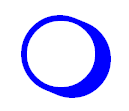|
29.Marius
The
western part of Oceanus Procellarum has few bigger craters, but is rich in
domes, specially around Marius. This area is of great geological interest,
and was going to be the target for an Apollo expedition. Because a number
of flights were cancelled due to budget cuts, this was not going to
happen.
MAESTLIN -
Michael Möstlin (1550 - 1631) German
mathematician and astronomer. Teacher of Johannes Kepler. Defended the
theory of Copernicus, and popularized Kepler and his heliocentric
Copernican theory. Maestlin discovered that the ashen grey Moonlight is
actually light reflected back from the Earth.
 Crater.
(7.1km /4Mi
ø
) (Dept:
1,650m /5,000ft) (5.0°N, 41°W) Small isolated circular formation, bowl
shape, steep slopes. To the north the remains of walled plain Meastlin R
(60km
ø
). Crater.
(7.1km /4Mi
ø
) (Dept:
1,650m /5,000ft) (5.0°N, 41°W) Small isolated circular formation, bowl
shape, steep slopes. To the north the remains of walled plain Meastlin R
(60km
ø
).
MARIUS -
Simon Mayer. (1570
- 1624) German astronomer, on of the first who used a telescope.
Discovered the
Andromeda Nebula, and must have seen the
moons of Jupiter, for he named them with their present names.
 Crater.
(42km /25Mi
ø
) (Dept: 1,670m /5,100ft)
(12°N, 51.0°W)
Irregularly shaped, flooded with lava. On the level floor we find the
small crater Marius G. (3.3km /2Mi
ø
) Crater.
(42km /25Mi
ø
) (Dept: 1,670m /5,100ft)
(12°N, 51.0°W)
Irregularly shaped, flooded with lava. On the level floor we find the
small crater Marius G. (3.3km /2Mi
ø
)
OCEANUS PROCELLARUM -
Ocean of Storms.
Named by
Riccioli, (1651).
Riccioli's Moon Map.
 Ocean.
(721x488Km / 448x303Mi) (Centre: about 0.0° N, 50.0° W) Procellarum is the
largest of the maria, stretching more than 2,500 km (1,600 Mi) across its
north-south axis and covering roughly 2,102,000 km2. Larger
lunar sea. Very flat to the center. 80m altitude difference in a 400 km
diameter circle. Numerous ridges rilles, leftovers of walls. Ghost craters
and lava flooded craters, many small hills. The landscape of the area
depicted on Chart
41 is basically the same. Rays from
Crater Copernicus and other ray craters. The robotic lunar probes Luna 9,
Luna 13, Surveyor 1 and Surveyor 3 landed in Oceanus Procellarum. The
manned Apollo 12 mission also landed in Oceanus Procellarum, with
astronauts Pete Conrad and Alan Bean on board. Their landing site, within
300m of Surveyor 3, has become known as Mare Cognitum. North of Euclides F
(5.2 km
ø
)
(Dept: 1,090m), and in surroundings of Herigonius are ridges which should
be counted amongst the most articulated systems on the Moon. In Chart 29
we find the rays of the crater Kepler. Ocean.
(721x488Km / 448x303Mi) (Centre: about 0.0° N, 50.0° W) Procellarum is the
largest of the maria, stretching more than 2,500 km (1,600 Mi) across its
north-south axis and covering roughly 2,102,000 km2. Larger
lunar sea. Very flat to the center. 80m altitude difference in a 400 km
diameter circle. Numerous ridges rilles, leftovers of walls. Ghost craters
and lava flooded craters, many small hills. The landscape of the area
depicted on Chart
41 is basically the same. Rays from
Crater Copernicus and other ray craters. The robotic lunar probes Luna 9,
Luna 13, Surveyor 1 and Surveyor 3 landed in Oceanus Procellarum. The
manned Apollo 12 mission also landed in Oceanus Procellarum, with
astronauts Pete Conrad and Alan Bean on board. Their landing site, within
300m of Surveyor 3, has become known as Mare Cognitum. North of Euclides F
(5.2 km
ø
)
(Dept: 1,090m), and in surroundings of Herigonius are ridges which should
be counted amongst the most articulated systems on the Moon. In Chart 29
we find the rays of the crater Kepler.
REINER -
Vincentio Reinieri. (1606-1647) Italian
Mathematician, friend of Galileo Galilei.
 Crater.
(30km /18Mi
ø
) (Dept: 2,580m /7,800ft) (7°N, 55°W) Circular crater,
sharp-edged rim. Central mountain. Crater.
(30km /18Mi
ø
) (Dept: 2,580m /7,800ft) (7°N, 55°W) Circular crater,
sharp-edged rim. Central mountain.
SUESS -
Edward Suess.
(1831-1914) Austrian selenologist, geologist, paleontologist. One
of the first modern geologists. Theory about the
extraterrestrial source of tektites. (Moldavites).
 Crater.
(9.2km /6Mi
ø
)
(Dept: 0.5 km) (4°N,48°W)
Small rater. Forms an interesting trio with Suess D and Reiner B. Crater.
(9.2km /6Mi
ø
)
(Dept: 0.5 km) (4°N,48°W)
Small rater. Forms an interesting trio with Suess D and Reiner B.
|
|
Kepler |
C |
12.2km |
Dept: 2,170m |
|
|
Kepler |
D |
10.0km |
Dept: 0,350m |
|
|
Kepler |
E |
05.2km |
Dept: 1,000m |
|
|
Maestlin |
G |
02.8km |
Dept:
0,670m |
|
|
Maestlin |
H |
07.1km |
Dept: 1,370m |
29.
|
|

|
